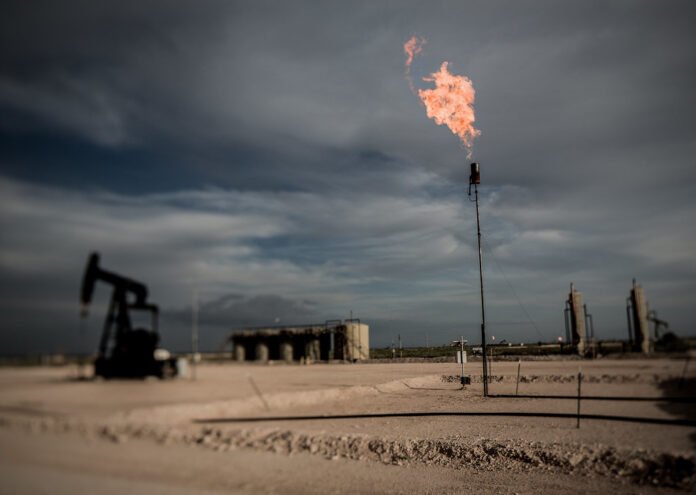Surging energy production in the Permian Basin of West Texas and Southeastern New Mexico has meant a financial windfall for the area and the United States as a whole, but a lack of infrastructure is holding back the region says a new report from the Permian Strategic Partnership.
Given the region’s booming growth in the past decade, investments in transportation and other infrastructure are overdue, the report argues, and investment now would reap benefits in safety and efficiency.
“The booming economy thus far in West Texas and Southeast New Mexico has outstripped the intended capacity for our roads, which honestly were built so many years ago when the economy in the Permian was largely agricultural-based,” said Tracee Bentley, head of the Permian Strategic Partnership, in an interview with Western Wire.
“That’s how far back our infrastructure goes. And we’ve kind of piecemealed it together to get by as the energy sector grew and grew and became the major heartbeat of the economy, but we’ve never really built the infrastructure out here for the industry that’s driving it.”
High-paying jobs in the energy sector had drawn thousands of workers and their families to New Mexico and Texas. This has led to record-setting state tax receipts. Last year, New Mexico schools and the state’s General Fund benefited from $3.1 billion in oil and gas taxes and revenues, an increase of $910 million from the year before.
This money has not made it to Permian-area infrastructure though. Built for a smaller population and not intended for heavy equipment, roads, traffic signals, and other infrastructure has failed to keep up with the growth.
As a result, many areas lack quality education and healthcare infrastructure and overcrowding on roads has led to thousands of excess traffic fatalities.
“The boom in the Permian has created a number of severe problems and among those, one of the most important is the state of the roads out there,” Prof. Jim Peach, an economist at New Mexico State University told Western Wire. “Traffic fatalities are way up [since the start of the Permian boom] and you can almost track that with oil production or active rigs. And that’s the main focus of the report.”
Hydraulic fracturing requires large quantities of sand and water which must be trucked into the oil field along with other equipment and supplies. Developing a horizontal well requires 4,000 to 7,000 truck trips within a period of 45 to 75 days, the researchers found. At the height of Permian projection, the area’s 550 rigs meant more than 3.8 million truck trips.
This has led to congestion and a dramatic increase in accidents, the report found. In 2018, Permian Basin experienced more than 18,300 vehicle accidents, including 5,000 injuries and 271 fatalities.
“A lot of it is outdated infrastructure, when you don’t have shoulders or proper off and on ramps, huge safety issues,” said Bentley.
In the past decade, the industry has paid billions of dollars in taxes and fees into state coffers. In 2019 alone, oil and gas development paid $8 billion into the coffers of Texas and New Mexico.
For both states, energy production is an important source of revenue to cover education spending and general state revenues. Most years, revenues from mineral and energy development are more than 30 percent of the total revenue of New Mexico’s General Fund.
This trend is projected to continue in coming years. According to an analysis by researchers from Texas A&M University, the Permian Basin will pay a cumulative $1.4 billion in severance taxes to New Mexico.
Reinvestment of some of this money into Permian Basin roads would yield large returns. The researchers found that a $1 billion investment in roads in the Permian basin would lead to many fewer fatalities and injuries and save drivers 2.1 million hours of traffic delays. They predict that these factors alone would return $1.5 billion in economic benefits.
“The oil and gas industry contributes heavily to state government finances in both Texas and New Mexico. And it is generally the responsibility in New Mexico of the State Department of Transportation to make improvements to roads,” said Peach. “And it’s badly needed.”
The issue is starting to get attention from lawmakers. Earlier this year, the New Mexico Department of Transportation announced that it had secured $130 million of funding to rebuild U.S. Highway 285 to better serve increased truck traffic in the area.
In addition, the Permian is beginning to see some federal funding for roads. The U.S. Department of Transportation announced on Thursday a $25 million grant to fix a stretch of I-20 in Texas. The state is also stepping up to provide funding, but continued investment is necessary, Bentley stresses.
“We’re starting to see investment from the U.S. DOT, we have a commitment from the state of Texas to the tune of $660 million over the next biennium that the Texas Department of Transportation has specifically dedicated towards Permian Basin roads in West Texas, and then you’ve got private industry stepping up,” she said. “So we think that we’ve got a really good model out here that we need to keep going.”
Part of keeping the model going is expanding investment in non-transportation infrastructure, which is also undersized for current population levels. As the industry grows, public services in fields like healthcare and schools will also need investment.
“In addition to roads, the Permian’s workforce needs affordable housing, good public schools, and hospitals staffed with an adequate number of physicians, nurses, and staff,” the report concludes. “These are not problems that are solved overnight, but with sufficient funding and investments in the right places, the Permian will be in the best position possible to succeed.”
Oil and gas revenues are already a key driver of education funding in Colorado and New Mexico. According to estimates from the New Mexico Oil and Gas Association, the state saw the equivalent of nearly $2,500 per pupil in funding from the state’s oil and gas industry in 2018.

